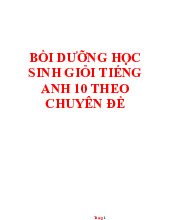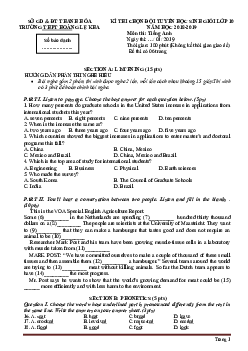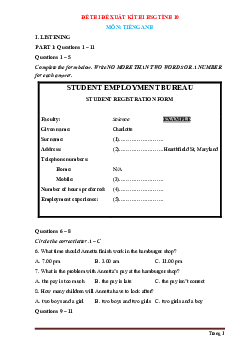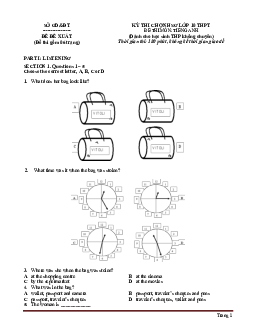








Preview text:
SỞ GD&ĐT VĨNH PHÚC
KÌ THI CHỌN HSG LỚP 10, 11 THPT NĂM HỌC 2017 – 2018
ĐỀ THI MÔN: TIẾNG ANH 10 – THPT
Thời gian làm bài: 180 phút, không kể thời gian giao đề ĐỀ CHÍNH THỨC
(Đề thi gồm 06 trang)
SECTION A. LISTENING (Each recording will be played TWICE)
Part 1: Questions 1-7. There are seven questions in this part. For each question, there are three
pictures and a short recording. Choose the correct picture A, B or C. 1. What is the girl doing? A B C
2. What will the weather be like tomorrow? A B C
3. Which musical instrument is the girl learning to play? A B C 4. Where will they meet? A B C
5. What time does the museum shut on Saturdays? Trang 1 A B C 6. Where is the flat? A B C
7. What did the woman receive in the post? A B C
Part 2. Questions 8-13. You will hear a man called Toby Merchant talking on the radio about his job
as an engineer with a company called Atkins Engineering. Choose the best answer A, B or C for each of the following questions.
8. When did Toby get a job with Atkins Engineering?
A. when he was a university student
B. as soon as he finished university
C. six months after he finished university
9. What is Toby working on at the moment? A. new motorway B. houses and flats C. a new airport
10. When Toby began working, he was surprised to spend so much time_____. A. talking to other people B. sitting in an office C. designing buildings
11. Young people often don’t choose engineering because they think _______. A. it’s hard to get a job B. it’s probably boring C. it’s very well paid
12. What is a disadvantage of the job for Toby?
A. He finds it difficult to take holidays.
B. He can’t organize his spare time. C. He works too many hours.
13. When Toby was at school, what job did he want to have? A. a doctor B. an architect C. an engineer
Part 3. Questions 14-20. Complete the notes bellow.
Write NO MORE THAN THREE WORDS AND / OR A NUMBER for each answer. Trang 2 GOODWOOD CAR SHOW
Type of car: Duesenberg J-type Number made: (14) ___________ Type of body: two-seater
Engines contained capsules of mercury to ensure a (15) _________ trip.
Top speed: (16) ___________ per hour Sold as a frame and engine
Main attraction: instrument panel Type of car: Leyat Helica
Number built: (17) ___________
Car looks like a (18) ___________ without (19) _______.
Steering used the (20) ___________. SECTION B. PHONETICS
Pick out the word whose stress pattern is different from that of the other words. Identify your answer
by writing the corresponding letter A, B, C or D on your answer sheet. 1. A. alarming B. criticize C. excellent D. arrogant
2. A. presentation B. confidential C. controversial D. communicate 3. A. ambitious B. appearance C. development D. introduce
4. A. economical B. alternative C. miraculous D. ability 5. A. ingratiate B. politics C. courageous D. conspicuous SECTION C. LEXICO-GRAMMAR
Part 1. Complete the following sentences by choosing the correct answer A, B, C or D.
1. ________ daily promotes physical as well as emotional well-being in people of all ages. A. Having exercised B. Those who exercise C. Exercising D. For exercising
2. The new production of Othello is very ambitious and extremely interesting, but somehow it doesn't quite ________ . A. come off B. come through C. come out D. come round
3. These tablets are really ________. My headache’s much better now. A. affective B. effective C. efficient D. affected
4. Doctors advise people who are deficient ________ vitamin C to eat more fruit and vegetables. A. from B. of C. in D. for
5. “But son, you are my own ________. ” A. flesh and blood B. body and soul C. heart to heart D. skin and bone
6. The TV documentary was so informative that we were all ________ to the set until it ended. A. glued B. secured C. hooked D. united
7. By the time the bridge is complete, over $20 million ________ on the project. A. will have been spent B. is to be spent C. will be spending D. is going to spend
8. Linda: “It’s really the end of the holiday already.” ~ Alice: “________!” A. How time flies B. Let’s call it a day C. It’s a small world D. There’s nothing to it
9. Harold would sooner we ________ the meeting on Sunday. A. shouldn’t hold B. wouldn’t hold C. didn’t hold D. won’t hold
10. Susan will graduate in June, ________ she submits her dissertation on time. A. unless B. provided C. otherwise D. supposing
Part 2. Supply the correct form of the word provided in each blank. Trang 3
Many (1. RESEARCH) ________ believe that apes can communicate with human beings. Investigations
made at several laboratories in the United States and elsewhere indicate that chimpanzees and gorillas are
capable of understanding language and line using (2. LANGUAGE) ________ responses at the level of a
four – year – old child. Washoe, an adult chimpanzee who was raised as if she were a deaf child, can
translate words she hears into American Sign Language. Loko, a 400-pound lowland gorilla, is claimed to
have understood a poem (3. WRITE) ________ about her. Tests of Koko’s auditory comprehension show
that she is able to make discriminations between such words as “funny”, “money”, and “bunny”.
The (4. SCIENCE) ________ at the forefront of this research admit that their work has been severely
criticized. The skeptics in general claim that apes’ language (5. BEHAVE) ________ is merely imitative.
For this behavior to be called “language”, it must also be (6. COMMUNICATE) ________. The proponents
of ape language counter that those who deny the (7. VALID) ________ of this research have never worked
with apes. They point out that new fields of investigation always create (8. CONTROVERSIAL)
________. They add that (9. HUMAN) ________ primates have not been taught to speak, however, because
the outer layer of their brain hemispheres is not (10. SUFFICIENT) ________refined.
Part 3. The passage below contains five mistakes. Write down the line numbers, the corresponding
mistakes and correct them.
It is a sad fact that adults laugh farly less than children, sometimes by as much as a couple of hundred
times a day. Just take a look at people's faces on the way to work or in the office: you'll be lucky to see a
smile, let alone hear a laugh. This is a shame - especially in view of the fact that scientists have proved that
laughing is good at you. "When you laugh" says psychologist David Cohen, "it produces the feel-good
hormones, endorphin. It counters the effects of stress and enhances the immune system."
They are many reasons why we might laugh less in adult life: perhaps we are too work-obsessed, or too
embarrassed to let our emotions shown. Some psychologists simply believe that children have more native
responses and like adults we naturally grow out of spontaneous reactions. Luckily, however, it is possible to relearn the art of laughter. No Line Mistake Correction 1 2 SECTION D. READING
Part 1. Read the following passage and choose the correct answer by writing the corresponding letter
A, B, C or D on your answer sheet.
The history of clinical nutrition, or the study of the relationship between health and how the body
takes in and utilizes food substances, can be divided into four distinct eras: the first began in the
nineteenth century and extended into the early twentieth century when it was recognized for the first time
that food contained constituents that were essential for human function and that different foods provided
different amounts of these essential agents. Near the end of this era, research studies demonstrated that rapid
weight loss was associated with nitrogen imbalance and could only be rectified by providing adequate
dietary protein associated with certain foods.
The second era was initiated in the early decades of the twentieth century and might be called "the
vitamin period." Vitamins came to be recognized in foods, and deficiency syndromes were described. As
vitamins became recognized as essential food constituents necessary for health, it became tempting to Trang 4
suggest that every disease and condition for which there had been no previous effective treatment might be
responsive to vitamin therapy. At that point in time, medical schools started to become more interested in
having their curricula integrate nutritional concepts into the basic sciences. Much of the focus of this
education was on the recognition of vitamin deficiency symptoms. Herein lay the beginning of what
ultimately turned from ignorance to denial of the value of nutritional therapies in medicine. Reckless claims
were made for effects of vitamins that went far beyond what could actually be achieved from the use of them.
In the third era of nutritional history in the early 1950's to mid-1960's, vitamin therapy began to fall into
disrepute. Concomitant with this, nutrition education in medical schools also became less popular. It was
just a decade before this that many drug companies had found their vitamin sales skyrocketing and were
quick to supply practicing physicians with generous samples of vitamins and literature praising the virtue of
supplementation for a variety of health-related conditions. Expectations as to the success of vitamins in
disease control were exaggerated. As is known in retrospect, vitamin and mineral therapies are much less
effective when applied to health-crisis conditions than when applied to long-term problems of under
nutrition that lead to chronic health problems.
1. What does the passage mainly discuss?
A. The effects of vitamins on the human body
B. The history of food preferences from the nineteenth century to the present
C. The stages of development of clinical nutrition as a field of study
D. Nutritional practices of the nineteenth century
2. It can be inferred from the passage that during the first era in the history of nutrition________.
A. protein was recognized as an essential component of diet
B. vitamins were synthesized from foods
C. effective techniques of weight loss were determined
D. certain foods were found to be harmful to good health
3. It can be inferred from the passage that medical schools began to teach concepts of nutrition in order to________.
A. convince medical doctors to participate in research studies on nutrition
B. encourage medical doctors to apply concepts of nutrition in the treatment of disease
C. convince doctors to conduct experimental vitamin therapies on their patients
D. support the creation of artificial vitamins
4. The word “them” in paragraph 2 refers to________. A. therapies B. claims C. effects D. vitamins
5. Why did vitamin therapy begin losing favor in the 1950's?
A. Because the public lost interest in vitamins.
B. Because medical schools stopped teaching nutritional concepts.
C. Because nutritional research was of poor quality.
D. Because claims for the effectiveness of vitamin therapy were seen to be exaggerated.
6. The phrase "concomitant with" in paragraph 3 is closest in meaning to________.
A. in conjunction with B. prior to C. in dispute with D. in regard to
7. The word "skyrocketing" in paragraph 3 is closest in meaning to________. A. internationally popular B. increasing rapidly C. acceptable D. surprising
8. The paragraph following the passage most probably discusses________.
A. the fourth era of nutrition history
B. problems associated with under nutrition
C. how drug companies became successful
D. why nutrition education lost its appeal Trang 5
(Source: TOEFL READING collection 2, 1995)
Part 2. Read the passage and fill in each numbered gap with ONE suitable word.
Fog is a cloud in (1) ________ with or just above the surface of land or sea. It can be a major
environmental hazard. Fog on highways can cause chain-reaction accidents involving dozens of cars. Delays
and shutdowns at airports can (2) ________ economic losses to airlines and inconveniences to thousands of
travelers carrying vast quantities of oil, increases the possibility of catastrophic oil spills.
The (3) ________ common type of fog, radiation fog, forms at night, when moist air near the ground
loses warmth through radiation on a clear night. This type of fog often occurs in valleys, (4) ________ as
California's San Joaquin Valley. (5) ________ common type, advection fog, results from the movement of
warm, wet air over cold ground. The air loses temperature to the ground and condensation sets in. This type
of fog often occurs along the California coast and the shores of the Great Lake. Advection fog also forms
when air (6) ________ with a warm ocean current blows across the surface of a cold current. The thick fogs
of the Grand Banks of Newfoundland, Canada, are largely of this origin, (7) ________ here the Labrador
Current comes in contact with the warm Gulf Stream.
Two other types of fog are somewhat (8) ________ unusual. Frontal fog occurs when two fronts of
different temperatures meet, and rain from the warm front falls (9) ________ the colder one, saturating the
air. Steam fog appears when cold air picks (10) ________ moisture by moving other warmer water.
Part 3. Choose the correct answer to complete the following passage by writing the corresponding
letter A, B, C or D on your answer sheet.
Of the myriad of Japanese ceremonies introduced to the West, the Japanese tea ceremony would have to
be the least accessible. (1) __________ many other aspects of Japanese culture, the practice of drinking tea
was (2) __________ from China well over a thousand years ago. In Japan, green tea developed its own
character, and the Japanese tea ceremony has evolved (3) __________ a peculiarly Japanese phenomenon.
The modern tea ceremony can be (4) __________back to the 17th century when it developed alongside
another singular Japanese adaption of Chinese culture: the philosophy of Zen. The tea ceremony eventually
became established as a recognized form of high art, where it was practiced in (5) __________ locations,
from a Zen temple to an ordinary home. Even today, the simplest and most secular tea ceremony still
embraces the Zen aesthetics of (6) __________, austerity and devotion. During the ceremony strictly
prescribed words of invitation and gratitude are murmured quietly; tea maker and guests (7) __________
their roles with humility and respect. A brief moment of (8) __________ tranquility has been communally
created and shared. It is simultaneously an aesthetic, social and spiritual moment. Significantly it is a
Japanese moment, fleeting and poignant with its own peacefulness (9) __________ the noise and confusion
of the everyday world is temporarily suspended as a vague, indefinable (10) __________ of the eternal pervades. 1. A. Like B. As C. Similar D. Alike 2. A. brought up B. brought in C. brought about D. brought down 3. A. off B. into C. about D. for 4. A. detected B. tracked C. ignored D. traced 5. A. disparate B. diverse C. equal D. unlike 6. A. simply B. simplify C. simplicity D. simplification 7. A. play B. take C. set D. have 8. A. heavy B. serious C. profound D. difficult 9. A. where B. when C. which D. who 10. A. sense B. thought C. capacity D. atmosphere SECTION E. WRITING
Part 1. Rewrite each of the following sentences in such a way that it has a similar meaning to the original one.
1. Although I love you, I cannot let you have any more money. Trang 6
→ Much _________________________________________________.
2. She was unaware that they were watching her every move.
→ Little did ______________________________________________.
3. It was a bad idea to invite them to the party.
→ You should ____________________________________________.
4. It is not a habit of mine to sleep in the afternoon.
→ I am __________________________________________________.
5. The letter arrived completely unexpectedly this morning.
→ The letter arrived completely out ____________________________. Part 2. Essay writing:
“Teenagers should be required to do unpaid work in their free time to help their local community.”
To what extent do you agree with this proposal?
Write an essay within 250 words to express your own idea. -----THE END-----
Thí sinh không được sử dụng tài liệu; Cán bộ coi thi không giải thích gì thêm.
Họ và tên thí sinh: …………………………………………………SBD:……………………… ĐÁP ÁN
SỞ GD&ĐT VĨNH PHÚC
KÌ THI CHỌN HSG LỚP 10, 11 THPT NĂM HỌC 2017 – 2018
HƯỚNG DẪN CHẤM MÔN: TIẾNG ANH 10 – THPT
(Đáp án gồm 02 trang)
SECTION A. LISTENING (4 points)
Part 1: (1.4 points. 0.2 points/ item) 1. B 2. C 3. A 4. B 5. C 6. B 7. A
Part 2. (1.2 points. 0.2 points/ item) 8. C 9. C 10. A 11. B 12. B 13. A
Part 3. (1.4 points. 0.2 points/ item) 14. 473 15. smooth 16. 180 kilometers 17. 30 18. light aircraft/ plane 19. wings 20. rear wheels
SECTION B. PHONETICS (1 point. 0.2 points/ item) 1. A 2. D 3. D 4. A 5. B Trang 7
SECTION C. LEXICO-GRAMMAR (5 points)
Part 1. (2 points. 0.2 points/ item) 1. C 2. A 3. B 4. C 5. A 6. A 7. A 8. A 9. C 10. B
Part 2. (2 points. 0.2 points/ item) 1. researchers 2. linguistic 3. written 4. scientists 5. behavior 6. communicative 7. validity 8. controversy 9. subhuman 10. sufficiently
Part 3. (1 points. 0.2 points/ item) No Line Mistake Correction 1 1 farly far 2 4 at for 3 6 They There 4 7 shown show 5 8 like as
SECTION D. READING (6 points)
Part 1. (2 points. 0.25 points/ item) 1. C 2. A 3. B 4. D 5. D 6. A 7. B 8. A
Part 2. (2 points. 0.2 points/ item) 1. contact 2. cause 3. most 4. such 5. Another 6. associated 7. because 8. more 9. into 10. up
Part 3. (2 points. 0.2 points/ item) 1. A 2. B 3. B 4. D 5. B 6. C 7. A 8. C 9. B 10. A SECTION E. (4 points)
Part 1. (1 point. 0.2 points/ item)
1. Much as I love you, I cannot let you have any more money.
2. Little did she know that they were watching her every move.
3. You should not have invited them to the party.
4. I am not used to/ not in the habit of sleeping in the afternoon.
5. The letter arrived completely out of the blue this morning. Trang 8
Part 2. (3 points)
The mark is based on the following criteria: 1. Content (1,2 pts) 1,2 pts
a. Providing all main ideas and details as required.
b. Communicating intentions sufficiently and effectively.
2. Organization and presentation (0,7 pt) 0,7 pt
a. Ideas are well-organized and presented with coherence, cohesion, and clarity. 0,7 pt
b. The essay is well-structured. 3. Language (0,7 pt)
a. Demonstration of a variety of vocabulary and structure appropriate to level of English 0,4 pt language of gifted students.
b. Good use and control of grammatical structures.
4. Punctuation, spelling and handwriting (0,4 pt)
a. Good punctuation and no spelling mistakes. b. Legible handwriting. TOTAL: 20 points _______The end_______ Trang 9



